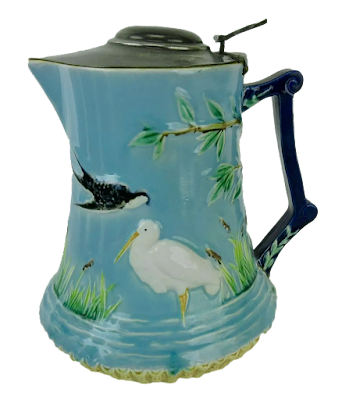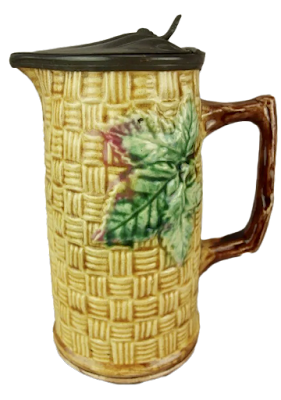Copeland majolica syrup/beverage pitcher
Considering the popularity of the majolica pitcher in the last half of the 19th century it was just a matter of time before these designs were put on double duty as syrup and beverage containers.
Syrup as a commodity is as old as mankind. Honey was used extensively in this Ancient Greece and Egypt and it is still in use in those countries today. Sugar cane was refined and used in China and India for thousand of years. Molasses, a distillation of the by-product of the cane sugar manufacturing process, was also used to sweeten things when refined sugar was too expensive to be made on a large scale. In the Americas, when people spoke of syrup in the Victorian period they generally meant molasses or maple syrup, a syrup popularized by indigenous people of the Western hemisphere from the sap of the maple tree.
Syrup’s unique viscous properties and great attraction to small insects, requires storage in a tightly enclosed container to maintain integrity, hence the creation of the syrup container. Most made of pottery or glass are covered with silver or pewter lids. A thumb press on the lid acts as a lever that allows for easy opening of the dispenser. There is also often a rest on the handle to prevent the lid from falling back too far when open. Syrup pitchers were particularly popular in England and the United States. Outside of those two, one doesn’t see many from continental potteries unless they were intended for export.
Beverage pitchers in the tradition of the German steins are another matter. They are seen throughout Europe. They were first invented and popularized in the 14th century to comply with Teutonic law which required lids on beverage pitchers to prevent the communication of disease. Although they are associated with German culture, their practicality has made them plentiful across the continent. They are constructed much like syrups with the difference really delineated by the larger size and traditionally tall cylindrical shape. These are sometimes referred to as tankards.
The pewter lids created for covered pitchers were always created by an outside firm contracted by the pottery. The metal lids are often marked with the name of the manufacturer. They are attached to the ceramic body by holes or notches at the rim created by the pottery that allow pins to secure the lid in place. In the case of some American syrups, these lids were permanently attached to the body by the use of plaster as an adhesive.
Some of the pitchers shown can function both as beverage and syrup containers, although I would hesitate to use the same pitcher for both. In some cases, as in the American examples shown, they have developed a conical shape which distinctly identifies them for syrup use. The smaller pitchers can be assumed are also intended for only syrup. Pewter lids were also made for teapots but I am not including them here.
Brown-Westhead Moore floral syrup/beverage pitcher
Etruscan Majolica Sunflower syrup pitcher
Etruscan Majolica Bamboo syrup pitcher
More frequently than majolica beverage pitchers, syrups are often badly stained with use from the dark syrups popular during the Victorian period. A soaking process will usually restore them to their former beauty. For information on cleaning stained majolica syrups, go here.











































































No comments:
Post a Comment